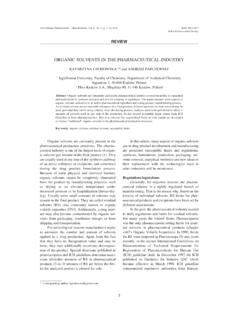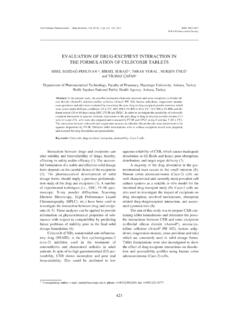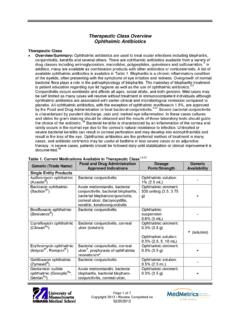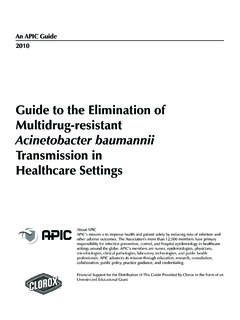Transcription of FLUOROQUINOLONE ANTIBACTERIALS: A REVIEW …
1 Acta Poloniae Pharmaceutica Drug Research, Vol. 66 No. 6 pp. 587 604, 2009 ISSN 0001-6837 Polish Pharmaceutical SocietyAntiinfective chemotherapy is the science ofadministering chemical agents to treat infectiousdiseases. This practice has proven to be one of themost successful of all pharmaceutical studies (1).Historically, the use of anti-infective agents can becredited with saving more human lives than anyother area of medicinal therapy discovered to chemotherapy accounts for the major-ity of antiinfective agents in comparison to antifun-gal, antiviral and antiparasitic agents. It is a highlyvalued medical science, which has shaped modernhumanity in a phenomenal fashion (1, 2).
2 Ehrlichsuccessfully developed the first purely synthetic rev-olutionary antimicrobial drug salvarsan in 1910 (2).Afterwards, beta-lactam antibiotic penicillins andsulfonamides have been the most promising or dom-inating drugs in clinical usage (3). Quinolones and fluoroquinolones are a rela-tively new class of synthetic antibiotics with potentbactericidal, broad spectrum activity against manyclinically important pathogens which are responsi-ble for variety of infections including urinary tractinfections (UTI), gastrointestinal infections (4), res-piratory tract infections (RTI), sexually transmitteddiseases (STD) and skin infections (5, 6).
3 They areprimarily used against urinary tract infections andare also clinically useful against prostatitis, infec-tions of skin and bones and penicillin resistant sex-ually transmitted diseases (4). These agents are alsoemployed against bacterial enteric infections, pro-phylaxis in the immuno compromised neutropenichost. New quinolones provide a valid alternativeantibacterial therapy, especially in areas where theprevalence of pencillin resistant and macrolideresistant organisms exist (7).Historical background The first clinically useful quinolone wasnaldixic acid, discovered by Lesher and co-workersin 1962, which was generated from chloroquine, anantimalarial agent (3).
4 It was active against someGram negative bacteria and had limited usefulnessbecause of its high protein binding (approximately90%) and little half life (about h) (8).Unfortunately, bacteria could develop a rapid resist-ance to this agent (9, 10). REVIEVFLUOROQUINOLONE ANTIBACTERIALS: A REVIEW ON CHEMISTRY,MICROBIOLOGY AND THERAPEUTIC PROSPECTS PRABODH CHANDER SHARMA1*, ANKIT JAIN1and SANDEEP JAIN21 Institute of Pharmaceutical Sciences, Kurukshetra University, Kurukshetra-136119, India2 Department of Pharmaceutical Sciences, Guru Jambheshwar University of Science and Technology, Hisar-125001, IndiaAbstract:Fluoroquinolones are one of the most promising and vigorously pursued areas of contemporary anti-infective chemotherapy depicting broad spectrum and potent activity.
5 They have a relatively simple molecularnucleus, which is amenable to many structural modifications. These agents have several favorable propertiessuch as excellent bioavailability, good tissue penetrability and a relatively low incidence of adverse and toxiceffects. They have been found effective in treatment of various infectious diseases. This paper is an attempt toreview the therapeutic prospects of FLUOROQUINOLONE antibacterials with an updated account on their develop-ment and : FLUOROQUINOLONE , antibacterial , ciprofloxacin, therapeutic587* Corresponding author: e-mail: CHANDER SHARMA et 1968, Kaminsky and Melfezer discovered anoxolinic acid, which was lately approved by theUnited States Food and Drug Administration(USFDA) (9).
6 Since then, extensive efforts has beenundertaken for the development and to derive anarray of significantly active drugs of this modification for the lead optimization bybioisosteric replacements, homologation of sidechain or branching of side chain, stereochemistryand other useful techniques of analogs design anddevelopment of fluoroquinolones have given rise toagents with broad spectrum activity and minimumtoxic or side effects. Development of new antibi-otics has been achieved from derivatives of knownantimicrobial agents or by identification of novelagents active against previously unexploited development has been focused on the followingaspects (3).
7 Increasing activity against resistant strains ofmicrobes, anaerobes and atypical rate of emergence of pharmacokinetics and pharmacody-namic towards selectivity of was the first fluoroquinolonewhich was patented in 1973, after that many fluoro-quinolones have been patented and are still usedtoday, including norfloxacin (1978), pefloxacin(1979), enoxacin (1980), fleroxacin (1981),ciprofloxacin (1981) and ofloxacin (1982) (3). Anadvantage of these compounds over previous ones istheir broad spectrum. A big revolution was made in1980 s when an analog of naldixic acid, enoxacinwas derived with significantly increased spectrum ofactivity against Gram negative or Gram positivebacteria (2).
8 The most successful and widely used fluoro-quinolone, ciprofloxacin was marketed in 1986, andsince then the value of fluoroquinolones for thetreatment of a wide range of infections have becomewidely recognized (3, 11). This class of compoundshas enhanced pharmacokinetic properties as well asextensive and potent activities against various para-sites, bacteria and mycobacteria, including resistantstrains as compared to previously existing bacterici-dal drugs (11, 12).ClassificationFluoroquinolones are classified (Table 1) onthe basis of their spectrum of activity and their phar-macokinetic profile (13).Structure-activity relationships (SAR)Essential structural featuresAll clinically important compounds of fluoro-quinolone class are synthetic fluorinated analoguesof naldixic acid, a 1,8-naphthyridine and possess a4-quinolone nucleus (14).
9 In general, pharmacophore required for signifi-cant antibacterial activity is 4-pyridone-3-carboxylicTable 1. Classification of fluoroquinolonesGeneration DrugCharacteristic featuresNaldixic acidActive against some Gram negative Oxolinic acidHighly protein bound acid Short half binding (50%).SecondCiprofloxacinLonger half life than previous activity against Gram negative TemafloxacinThird SparafloxacinActive against Gram negative Also active against Gram positive TrovafloxacinShow extended activity against both strains of against anaerobes and atypical antibacterials: a reviev on with a ring at 5 or 6 position (Fig.)
10 1). Now con-siderable information is available about the effects ofmodifications on nucleus. Although various alter-ations were done to improve antibacterial activity (3,4, 15-31), two major pathways of lead optimizationof original 1,8-naphthyridine nucleus were the strategies are based on modification of 6-fluoro and 7-piperazinyl quinolone (6). It is pertinent to mention here that a similarityis seen in many fluoroquinolones with beta lactams,wherein a reciprocal relationship is seen in both theclasses where an increase in Gram positive activityis associated with a decrease in Gram negative activ-ity (3).











